|
BULB LOG 12 - 23rd March 2005
What a difference a day makes. To anyone who wonders why we in Scotland (and the UK) are always going on about the weather, last week, as I mentioned in the log, we were still in the grips of the cold but with the promise from the forecasters that we would get a warm period. The day after I wrote the log the temperature shot up from around zero to 17 degrees centigrade for two days.
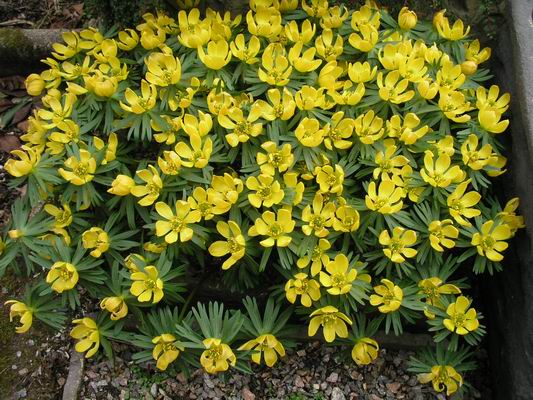
Eranthis 'Guinea Gold'
The warmth produced a massive push in growth from all the bulbs both in the garden and under glass. Eranthis 'Guinea Gold' opened its flowers as far as they would stretch and looked great until the heat pushed them over and the petals started to look tired. In the cold they can go on for weeks, the first flower opened six weeks ago, but this heat gives a great extravagant display for a short period. This is exactly what bulbs have evolved to do; sitting ready underground with roots and shoots formed waiting for favourable conditions to burst into a period of rapid growth when the temperature rises and moisture is available.

Corydalis in garden
The corydalis in garden also moved quickly and are now giving us a wonderful display (left) with pale pink 'Beth Evans' contrasting well with the creamy white of C. malkensis, and the deep purple solida seedling I showed you last week at the front.
Corydalis 'Beth Evans' always comes out that bit earlier than the darker brick red 'George Baker' but the two will usually be out together since 'George Baker' opens as 'Beth Evans' is just going passed her best. This overlap period will vary depending on the weather. A warm period like we have just had pushes 'Beth Evans' quickly to a peak then if we get a cold period again, which we will, this can delay the flowering of 'George Baker' so the effect of these plantings varies from year to year.
On the right are two of our own raised seedlings of Corydalis solida. The un-named pale pink form is superficially similar in colour to 'Beth Evans' but the dark red one we have named ' Craigton Red'.
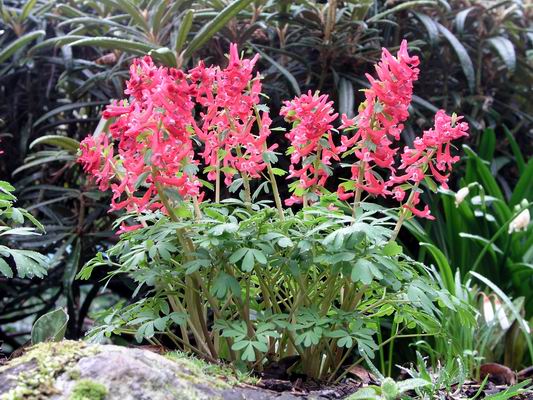
Corydalis 'Craigton Red'
The reasons we have selected this one from the many seedlings we have are: one, the colour is redder than any other solida type we have seen; two, it holds its flowers well on a strong spike well above the leaves and three, it flowers nice and early.
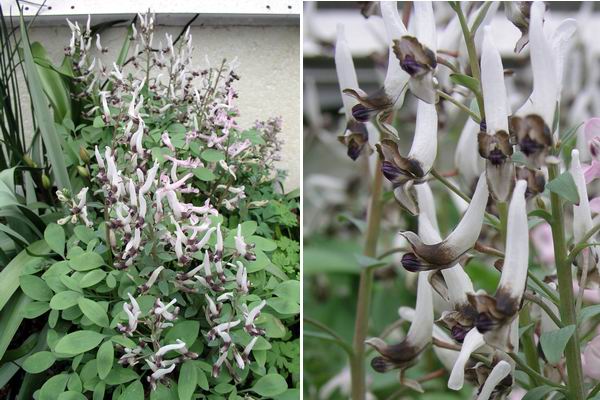
Corydalis nudicaulis
We also grow many corydalis in the bulb house like the stunning Corydalis nudicaulis with its dramatic colouring. I can always tell when these are in flower because most of them fill the glasshouse with their delightful honey-like scent, evolved to attract pollinators to the plant. Well it certainly does that because I am out there pulling my paint brush across their lip to both expose the anthers and style and with that simple action I also transfer the pollen and fertilise the plant - by doing this I ensure that we get a seed set.

Fritillaria sewertzowii
This is the Fritillaria sewertzowii that I got from Janis Rucksans as a 'Lilyflora' seedling, it is now fully out and it has much larger flowers than any other form of this plant that I have seen. The petals are 4cm long and the flower expands to 6cms wide when open, this is twice the size of the normal forms that we have.
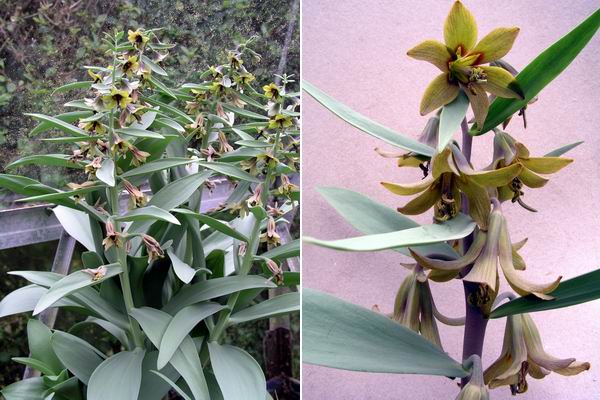
Fritillaria sewertzowii x2.jpg
Here it is again on the right with a normal form on the left. One of the reasons that we do not see this plant on the show benches more often can be seen on the plant to the left. The flowers open from the bottom of the scape, upwards and you can see that the lower flowers are going over as the upper ones are just coming out, this does not impress the judges who like to see all flowers looking fresh at the same time even if this is not what the plant does!
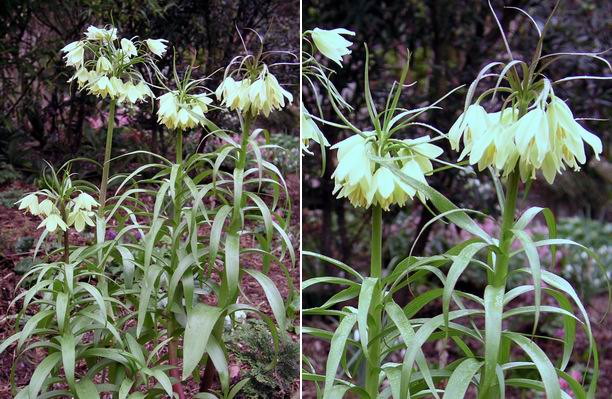
Fritillaria raddeana x2
One of the larger species, Fritillaria raddeana is also in full bloom and looking fantastic. This is another plant that does not always suit the show benches because of its size, it is just a bit big and looks out of place indoors, although I am glad to say we do see it at the shows even if the judges tend to walk past it.

Fritillaria yuminensis
Back under glass the very elegant Fritillaria yuminensis has opened its sweetly scented flowers. This is one of the frits that we do not mind sharing a car with on the long drive to a show; most of the species have a very putrid smell evolved to attract flies and wasps but not humans.

Fritillaria carica and caucasica
A couple more of the frits to flower encouraged by the warm weather are the yellow Fritillaria carica and the deep burgundy caucasica. With the warm weather producing all this growth I have given all the bulbs a very good watering and I also made sure that they have all now had a dose of the sulphate of potash. Our weather has now turned again and we have gone to cold and damp conditions with a moist cold sea haar (mist) shrouding the garden. These are perfect conditions for fungal attack and I must be vigilant and remove all fallen and dead petals as these are very quick to get botrytis which will transfer to the leaves and cause much harm to the plants - I also run fans to keep the air moving.

Erythronium tuolumnense x2
Two of our forms of Erythronium tuolumnense can be seen just coming out in this plunge bed. For a number of years I have been growing as many forms of this species as I could get hold of, both as bulbs and from seed and we now have a nice range showing how good a garden species it is. Some times the most common form in cultivation is not the best representative of the species and I think that this has been the case with Erythronium tuolumnense as while the form that has been common in the UK for many years is ok it is not the best that this species can offer.
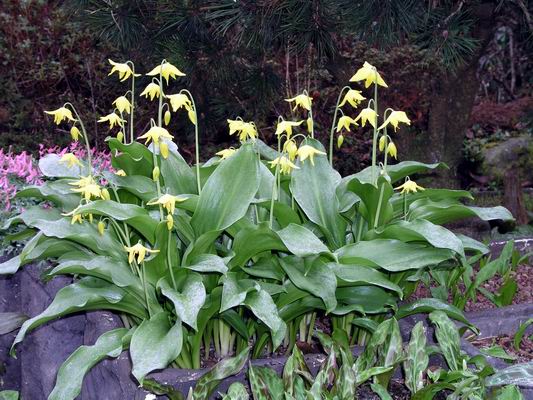
Erythronium tuolumnense
Above is another form which always opens a week or two earlier than the others that we now grow. These ones are growing in a deep polystyrene trough which makes it easy to tip them out when they are dormant and so speed up the increase by division of the bulb.

Narcissus snipe
I show this picture to illustrate the early stages of colour in the flowers of Narcissus 'Snipe'. They open bicoloured (right) then fade to a creamy white before they bleach out to nearer pure white. There has been much discussion and doubt to the name of this lovely narcissus in the UK but I am 100 percent that this is the true 'Snipe'.

Narcissus x susannae
I have just received some lovely pictures from Celestino Gelpi, of Narcissus x susannae growing in the wild, along with pictures of the parents of this naturally occurring hybrid, Narcissus cantabricus and triandrus. The question was, were our plants of the same parentage, though hybridised in cultivation, the same as the wild forms? Our form is pictured above and I will post Celestino's pictures on the forum (under bulb log feed back) along with some more of our own forms so you will be able to see for yourselves that they look identical to the naturally occurring forms.
^ back to the top ^
|

